Calculus and Linear Algebra Assignment: Step-by-Step Solutions
VerifiedAdded on 2023/04/08
|6
|1549
|233
Homework Assignment
AI Summary
This document presents detailed solutions to a calculus and linear algebra assignment, covering topics such as solving hyperbolic function equations, demonstrating properties of differentiable functions using the fundamental theorem of calculus, evaluating double integrals in polar coordinates, applying the fundamental theorem of calculus to iterated integrals, determining the equation of a plane in R3 given integral conditions, and using Gram-Schmidt orthogonalization to find an orthonormal basis for a subspace. Each problem is worked out step-by-step to provide a clear understanding of the solution process.
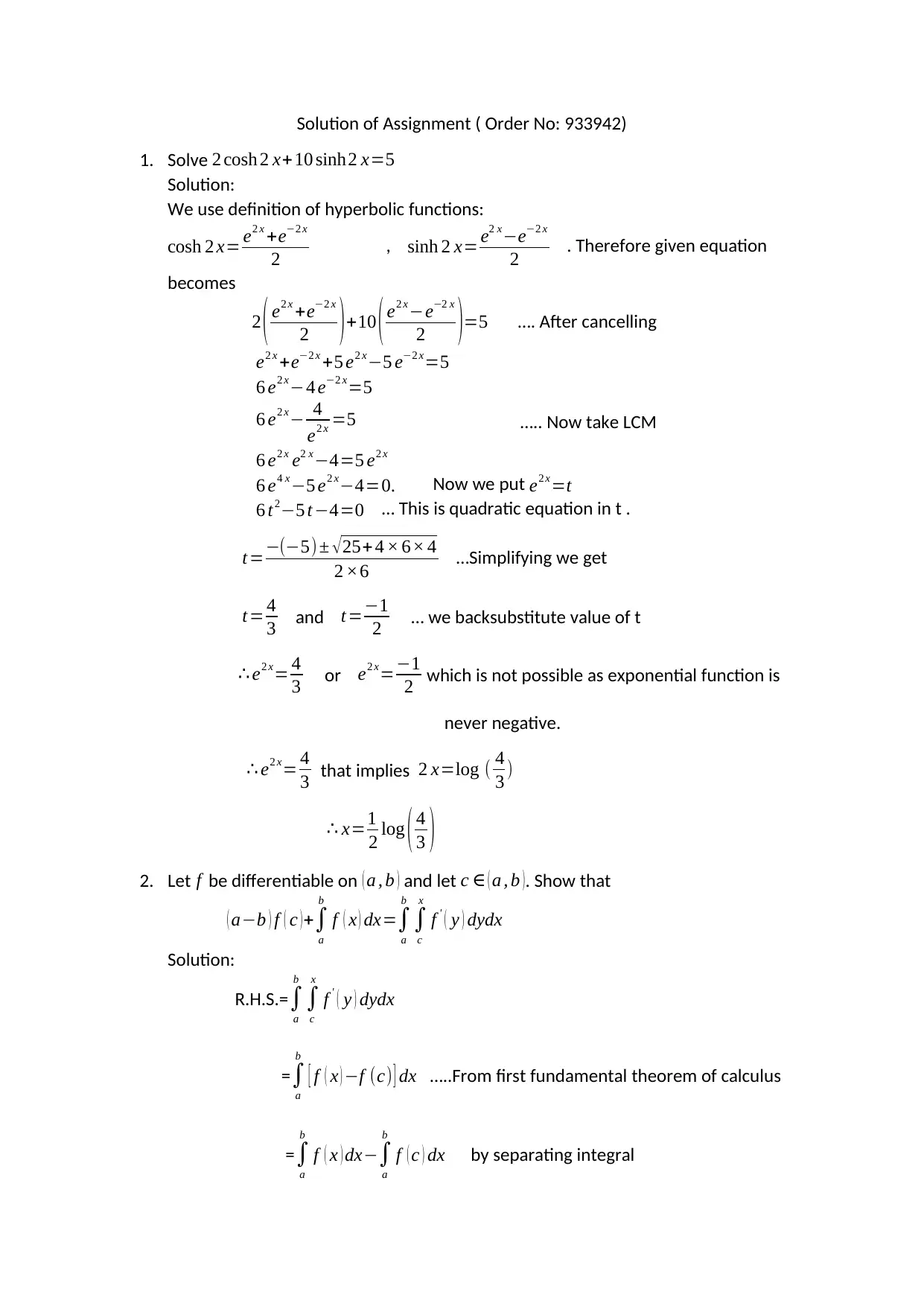
Solution of Assignment ( Order No: 933942)
1. Solve 2 cosh 2 x+10 sinh2 x=5
Solution:
We use definition of hyperbolic functions:
cosh 2 x= e2 x +e−2 x
2 , sinh 2 x= e2 x−e−2 x
2 . Therefore given equation
becomes
2 ( e2 x +e−2 x
2 )+10 ( e2 x−e−2 x
2 )=5 …. After cancelling
e2 x +e−2 x +5 e2 x−5 e−2 x=5
6 e2 x−4 e−2 x=5
6 e2 x− 4
e2 x =5 ….. Now take LCM
6 e2 x e2 x−4=5 e2 x
6 e4 x−5 e2 x−4=0. Now we put e2 x=t
6 t2−5 t−4=0 … This is quadratic equation in t .
t=−(−5) ± √ 25+ 4 × 6× 4
2 ×6 …Simplifying we get
t= 4
3 and t=−1
2 … we backsubstitute value of t
∴ e2 x= 4
3 or e2 x=−1
2 which is not possible as exponential function is
never negative.
∴ e2 x= 4
3 that implies 2 x=log ( 4
3 )
∴ x=1
2 log ( 4
3 )
2. Let f be differentiable on ( a , b ) and let c ∈ ( a , b ). Show that
( a−b ) f ( c ) +∫
a
b
f ( x ) dx=∫
a
b
∫
c
x
f ' ( y ) dydx
Solution:
R.H.S.= ∫
a
b
∫
c
x
f ' ( y ) dydx
= ∫
a
b
[ f ( x ) −f (c) ] dx …..From first fundamental theorem of calculus
= ∫
a
b
f ( x ) dx−∫
a
b
f ( c ) dx by separating integral
1. Solve 2 cosh 2 x+10 sinh2 x=5
Solution:
We use definition of hyperbolic functions:
cosh 2 x= e2 x +e−2 x
2 , sinh 2 x= e2 x−e−2 x
2 . Therefore given equation
becomes
2 ( e2 x +e−2 x
2 )+10 ( e2 x−e−2 x
2 )=5 …. After cancelling
e2 x +e−2 x +5 e2 x−5 e−2 x=5
6 e2 x−4 e−2 x=5
6 e2 x− 4
e2 x =5 ….. Now take LCM
6 e2 x e2 x−4=5 e2 x
6 e4 x−5 e2 x−4=0. Now we put e2 x=t
6 t2−5 t−4=0 … This is quadratic equation in t .
t=−(−5) ± √ 25+ 4 × 6× 4
2 ×6 …Simplifying we get
t= 4
3 and t=−1
2 … we backsubstitute value of t
∴ e2 x= 4
3 or e2 x=−1
2 which is not possible as exponential function is
never negative.
∴ e2 x= 4
3 that implies 2 x=log ( 4
3 )
∴ x=1
2 log ( 4
3 )
2. Let f be differentiable on ( a , b ) and let c ∈ ( a , b ). Show that
( a−b ) f ( c ) +∫
a
b
f ( x ) dx=∫
a
b
∫
c
x
f ' ( y ) dydx
Solution:
R.H.S.= ∫
a
b
∫
c
x
f ' ( y ) dydx
= ∫
a
b
[ f ( x ) −f (c) ] dx …..From first fundamental theorem of calculus
= ∫
a
b
f ( x ) dx−∫
a
b
f ( c ) dx by separating integral
Paraphrase This Document
Need a fresh take? Get an instant paraphrase of this document with our AI Paraphraser
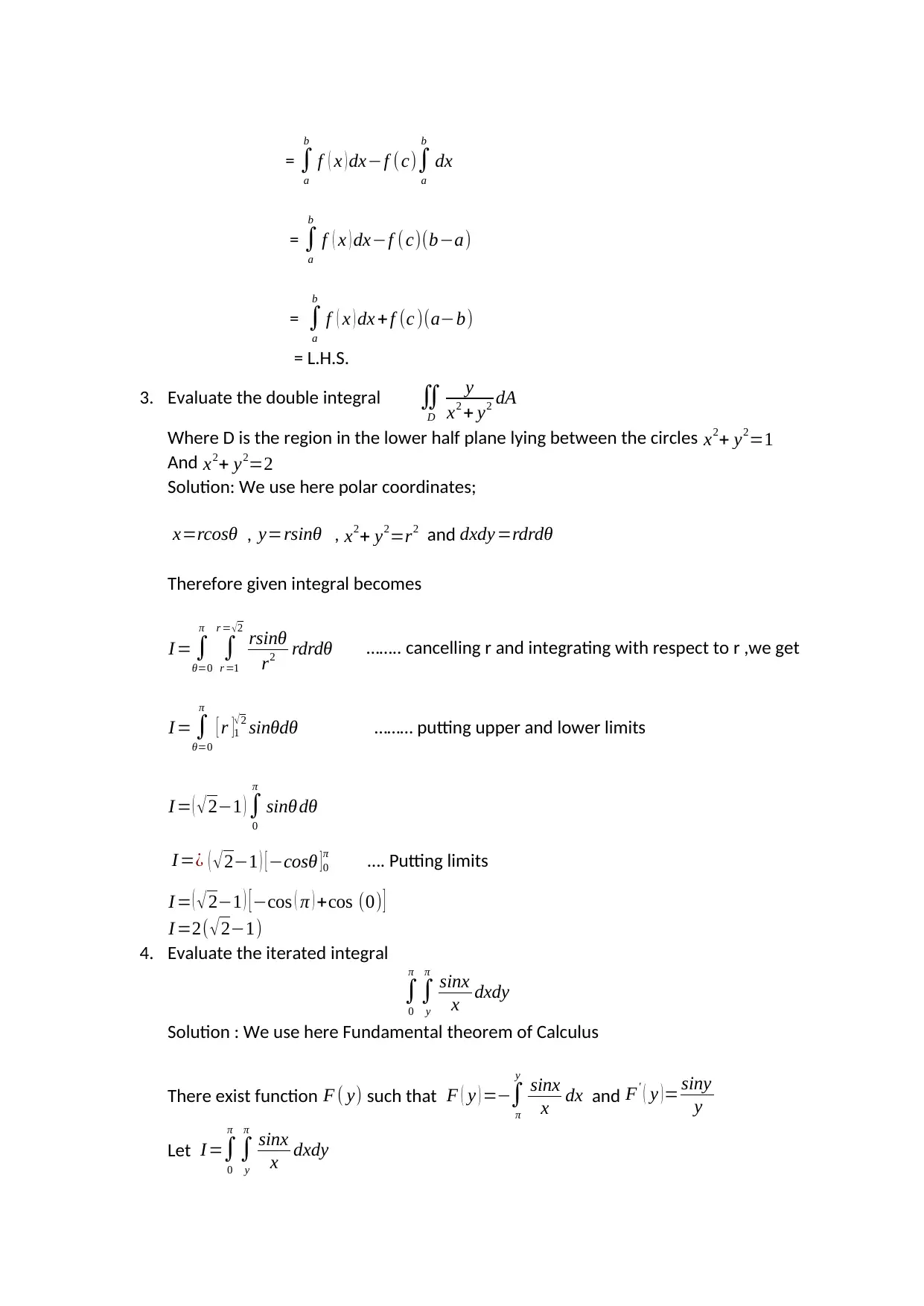
= ∫
a
b
f ( x ) dx−f (c)∫
a
b
dx
= ∫
a
b
f ( x ) dx−f (c)(b−a)
= ∫
a
b
f ( x ) dx + f (c )(a−b)
= L.H.S.
3. Evaluate the double integral ∬
D
y
x2 + y2 dA
Where D is the region in the lower half plane lying between the circles x2+ y2=1
And x2+ y2=2
Solution: We use here polar coordinates;
x=rcosθ , y=rsinθ , x2+ y2=r2 and dxdy =rdrdθ
Therefore given integral becomes
I = ∫
θ=0
π
∫
r =1
r = √ 2
rsinθ
r2 rdrdθ …….. cancelling r and integrating with respect to r ,we get
I = ∫
θ=0
π
[ r ]1
√ 2 sinθdθ ……… putting upper and lower limits
I = ( √ 2−1 ) ∫
0
π
sinθ dθ
I =¿ ( √2−1 ) [ −cosθ ]0
π …. Putting limits
I = ( √ 2−1 ) [ −cos ( π ) +cos (0) ]
I =2( √ 2−1)
4. Evaluate the iterated integral
∫
0
π
∫
y
π
sinx
x dxdy
Solution : We use here Fundamental theorem of Calculus
There exist function F ( y) such that F ( y ) =−∫
π
y
sinx
x dx and F' ( y )= siny
y
Let I =∫
0
π
∫
y
π
sinx
x dxdy
a
b
f ( x ) dx−f (c)∫
a
b
dx
= ∫
a
b
f ( x ) dx−f (c)(b−a)
= ∫
a
b
f ( x ) dx + f (c )(a−b)
= L.H.S.
3. Evaluate the double integral ∬
D
y
x2 + y2 dA
Where D is the region in the lower half plane lying between the circles x2+ y2=1
And x2+ y2=2
Solution: We use here polar coordinates;
x=rcosθ , y=rsinθ , x2+ y2=r2 and dxdy =rdrdθ
Therefore given integral becomes
I = ∫
θ=0
π
∫
r =1
r = √ 2
rsinθ
r2 rdrdθ …….. cancelling r and integrating with respect to r ,we get
I = ∫
θ=0
π
[ r ]1
√ 2 sinθdθ ……… putting upper and lower limits
I = ( √ 2−1 ) ∫
0
π
sinθ dθ
I =¿ ( √2−1 ) [ −cosθ ]0
π …. Putting limits
I = ( √ 2−1 ) [ −cos ( π ) +cos (0) ]
I =2( √ 2−1)
4. Evaluate the iterated integral
∫
0
π
∫
y
π
sinx
x dxdy
Solution : We use here Fundamental theorem of Calculus
There exist function F ( y) such that F ( y ) =−∫
π
y
sinx
x dx and F' ( y )= siny
y
Let I =∫
0
π
∫
y
π
sinx
x dxdy
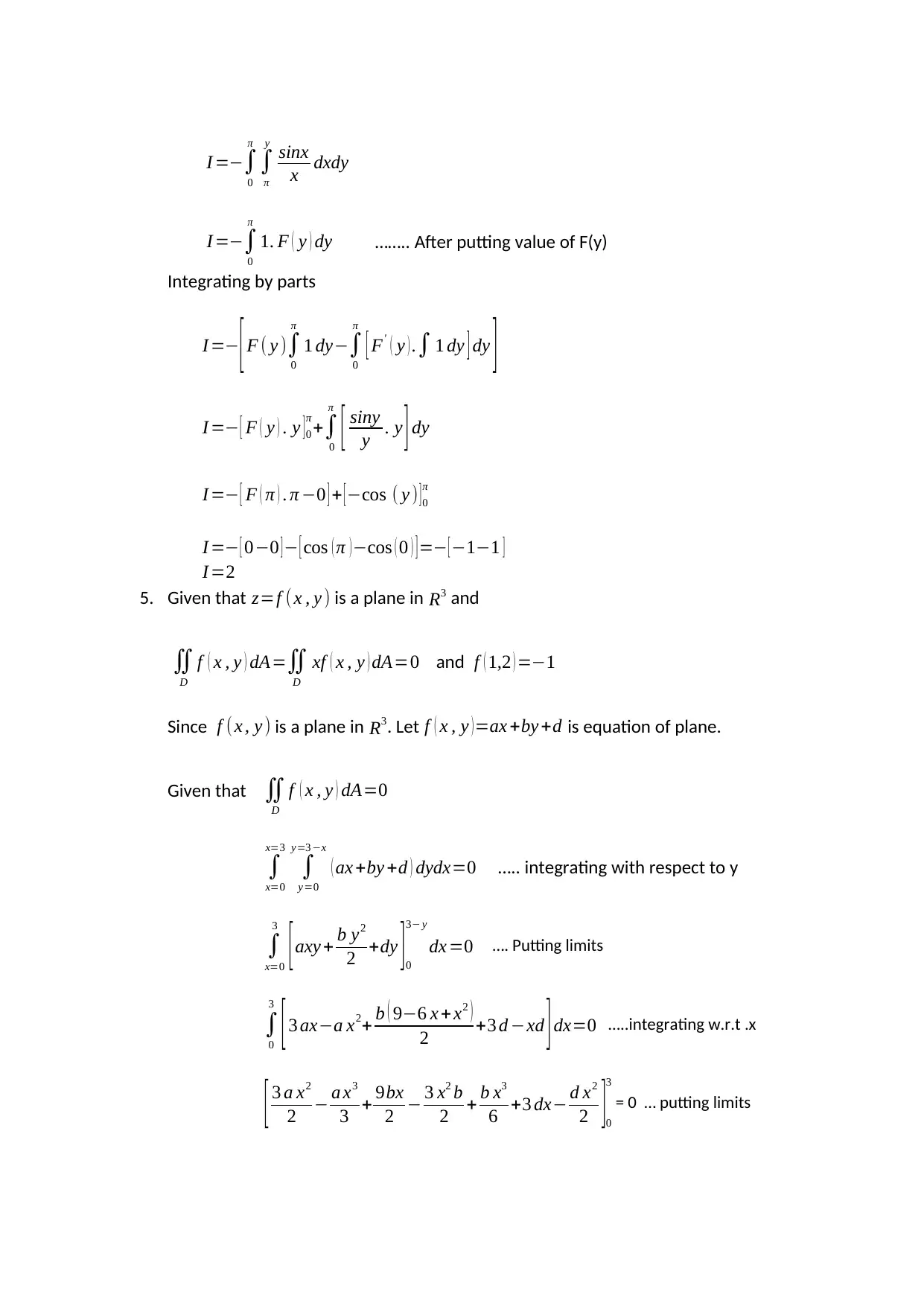
I =−∫
0
π
∫
π
y
sinx
x dxdy
I =−∫
0
π
1. F ( y ) dy …….. After putting value of F(y)
Integrating by parts
I =− [F ( y )∫
0
π
1 dy−∫
0
π
[ F' ( y ) .∫ 1 dy ] dy ]
I =− [ F ( y ) . y ] 0
π
+∫
0
π
[ siny
y . y ] dy
I =− [ F ( π ) . π −0 ] + [ −cos ( y ) ] 0
π
I =− [ 0−0 ] − [ cos ( π ) −cos ( 0 ) ] =− [ −1−1 ]
I =2
5. Given that z=f ( x , y ) is a plane in R3 and
∬
D
f ( x , y ) dA=∬
D
xf ( x , y ) dA=0 and f ( 1,2 ) =−1
Since f (x , y ) is a plane in R3. Let f ( x , y ) =ax +by +d is equation of plane.
Given that ∬
D
f ( x , y ) dA=0
∫
x=0
x=3
∫
y=0
y=3 −x
( ax +by +d ) dydx=0 ….. integrating with respect to y
∫
x=0
3
[axy + b y2
2 +dy ]0
3− y
dx =0 …. Putting limits
∫
0
3
[3 ax−a x2+ b ( 9−6 x + x2 )
2 +3 d −xd ]dx=0 …..integrating w.r.t .x
[ 3 a x2
2 − a x3
3 + 9bx
2 − 3 x2 b
2 + b x3
6 +3 dx− d x2
2 ]0
3
= 0 … putting limits
0
π
∫
π
y
sinx
x dxdy
I =−∫
0
π
1. F ( y ) dy …….. After putting value of F(y)
Integrating by parts
I =− [F ( y )∫
0
π
1 dy−∫
0
π
[ F' ( y ) .∫ 1 dy ] dy ]
I =− [ F ( y ) . y ] 0
π
+∫
0
π
[ siny
y . y ] dy
I =− [ F ( π ) . π −0 ] + [ −cos ( y ) ] 0
π
I =− [ 0−0 ] − [ cos ( π ) −cos ( 0 ) ] =− [ −1−1 ]
I =2
5. Given that z=f ( x , y ) is a plane in R3 and
∬
D
f ( x , y ) dA=∬
D
xf ( x , y ) dA=0 and f ( 1,2 ) =−1
Since f (x , y ) is a plane in R3. Let f ( x , y ) =ax +by +d is equation of plane.
Given that ∬
D
f ( x , y ) dA=0
∫
x=0
x=3
∫
y=0
y=3 −x
( ax +by +d ) dydx=0 ….. integrating with respect to y
∫
x=0
3
[axy + b y2
2 +dy ]0
3− y
dx =0 …. Putting limits
∫
0
3
[3 ax−a x2+ b ( 9−6 x + x2 )
2 +3 d −xd ]dx=0 …..integrating w.r.t .x
[ 3 a x2
2 − a x3
3 + 9bx
2 − 3 x2 b
2 + b x3
6 +3 dx− d x2
2 ]0
3
= 0 … putting limits
⊘ This is a preview!⊘
Do you want full access?
Subscribe today to unlock all pages.

Trusted by 1+ million students worldwide
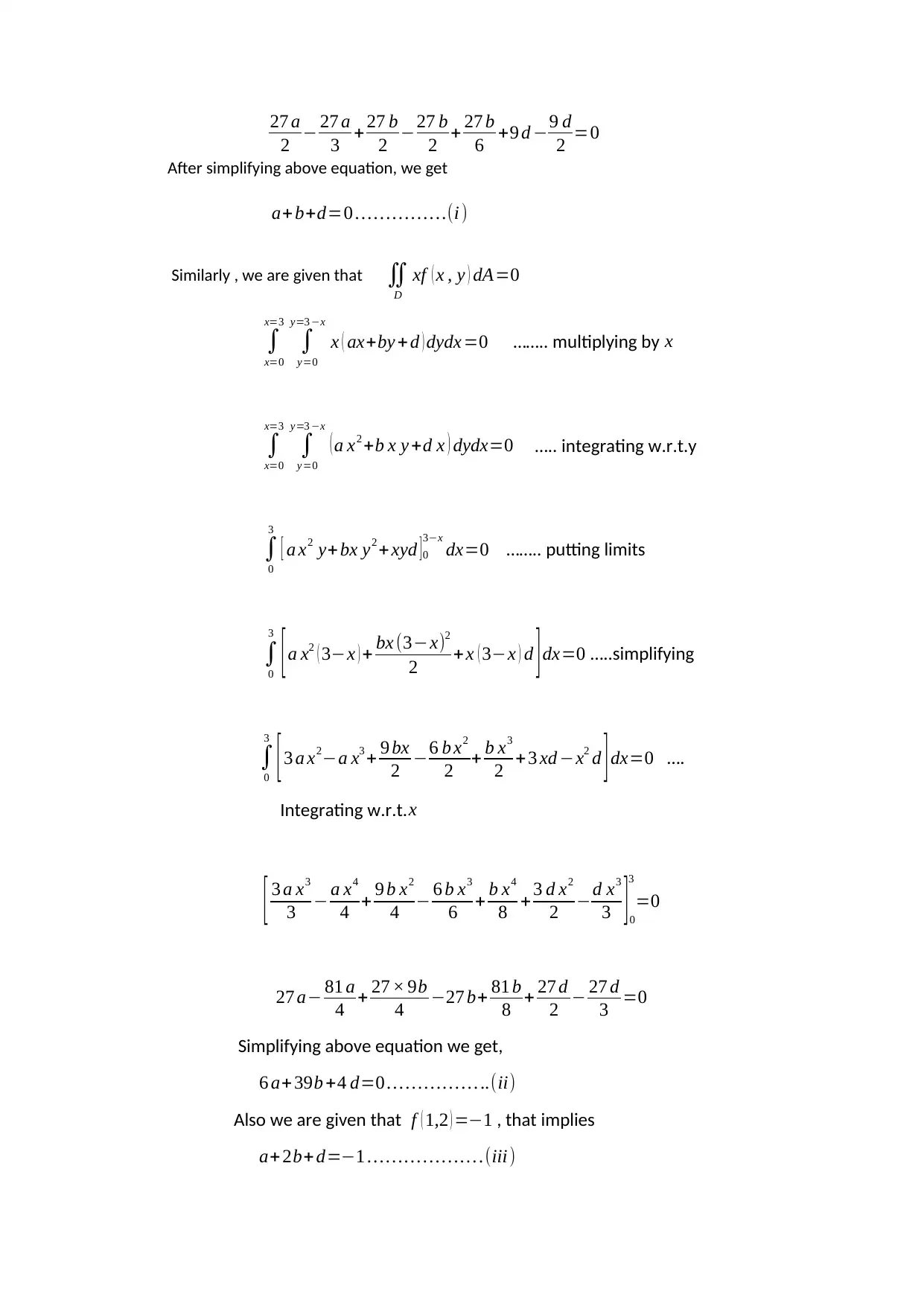
27 a
2 − 27 a
3 + 27 b
2 −27 b
2 + 27 b
6 +9 d −9 d
2 =0
After simplifying above equation, we get
a+ b+d=0 … … … … …(i )
Similarly , we are given that ∬
D
xf ( x , y ) dA=0
∫
x=0
x=3
∫
y=0
y=3 −x
x ( ax+by + d ) dydx =0 …….. multiplying by x
∫
x=0
x=3
∫
y=0
y=3 −x
( a x2 +b x y +d x ) dydx=0 ….. integrating w.r.t.y
∫
0
3
[ a x2 y+ bx y2 + xyd ] 0
3−x
dx=0 …….. putting limits
∫
0
3
[a x2 ( 3−x ) + bx (3−x)2
2 +x ( 3−x ) d ]dx=0 …..simplifying
∫
0
3
[ 3 a x2−a x3 + 9 bx
2 −6 b x2
2 + b x3
2 +3 xd −x2 d ] dx=0 ….
Integrating w.r.t.x
[ 3 a x3
3 − a x4
4 + 9 b x2
4 − 6 b x3
6 + b x4
8 +3 d x2
2 −d x3
3 ] 0
3
=0
27 a− 81 a
4 + 27 × 9b
4 −27 b+ 81 b
8 + 27 d
2 − 27 d
3 =0
Simplifying above equation we get,
6 a+ 39b +4 d=0 … … … … … ..(ii)
Also we are given that f ( 1,2 ) =−1 , that implies
a+ 2b+ d=−1 … …… … …… .(iii )
2 − 27 a
3 + 27 b
2 −27 b
2 + 27 b
6 +9 d −9 d
2 =0
After simplifying above equation, we get
a+ b+d=0 … … … … …(i )
Similarly , we are given that ∬
D
xf ( x , y ) dA=0
∫
x=0
x=3
∫
y=0
y=3 −x
x ( ax+by + d ) dydx =0 …….. multiplying by x
∫
x=0
x=3
∫
y=0
y=3 −x
( a x2 +b x y +d x ) dydx=0 ….. integrating w.r.t.y
∫
0
3
[ a x2 y+ bx y2 + xyd ] 0
3−x
dx=0 …….. putting limits
∫
0
3
[a x2 ( 3−x ) + bx (3−x)2
2 +x ( 3−x ) d ]dx=0 …..simplifying
∫
0
3
[ 3 a x2−a x3 + 9 bx
2 −6 b x2
2 + b x3
2 +3 xd −x2 d ] dx=0 ….
Integrating w.r.t.x
[ 3 a x3
3 − a x4
4 + 9 b x2
4 − 6 b x3
6 + b x4
8 +3 d x2
2 −d x3
3 ] 0
3
=0
27 a− 81 a
4 + 27 × 9b
4 −27 b+ 81 b
8 + 27 d
2 − 27 d
3 =0
Simplifying above equation we get,
6 a+ 39b +4 d=0 … … … … … ..(ii)
Also we are given that f ( 1,2 ) =−1 , that implies
a+ 2b+ d=−1 … …… … …… .(iii )
Paraphrase This Document
Need a fresh take? Get an instant paraphrase of this document with our AI Paraphraser
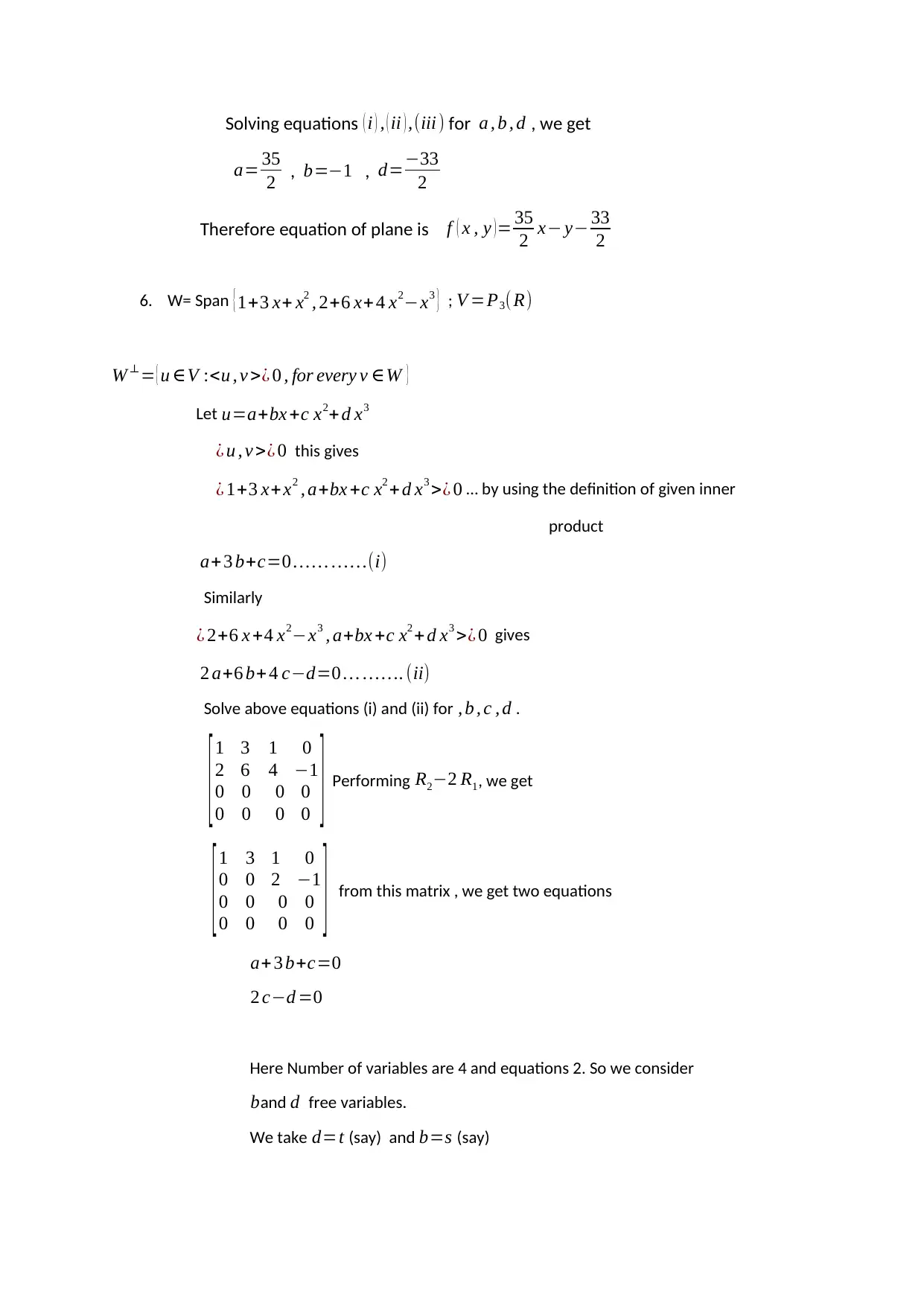
Solving equations ( i ) , ( ii ) ,(iii ) for a , b , d , we get
a= 35
2 , b=−1 , d=−33
2
Therefore equation of plane is f ( x , y )= 35
2 x− y− 33
2
6. W= Span {1+3 x+ x2 , 2+6 x+4 x2−x3 } ; V =P3( R)
W ⊥= { u ∈V :<u , v >¿ 0 , for every v ∈W }
Let u=a+bx +c x2+ d x3
¿ u , v >¿ 0 this gives
¿ 1+3 x+ x2 , a+bx +c x2 + d x3 >¿ 0 … by using the definition of given inner
product
a+3 b+c=0 … … … …(i)
Similarly
¿ 2+6 x +4 x2−x3 , a+bx +c x2 +d x3 >¿ 0 gives
2 a+6 b+ 4 c−d=0 … … …. (ii)
Solve above equations (i) and (ii) for , b , c , d .
[1 3
2 6
1 0
4 −1
0 0
0 0
0 0
0 0 ] Performing R2−2 R1, we get
[1 3
0 0
1 0
2 −1
0 0
0 0
0 0
0 0 ] from this matrix , we get two equations
a+3 b+c=0
2 c−d =0
Here Number of variables are 4 and equations 2. So we consider
band d free variables.
We take d=t (say) and b=s (say)
a= 35
2 , b=−1 , d=−33
2
Therefore equation of plane is f ( x , y )= 35
2 x− y− 33
2
6. W= Span {1+3 x+ x2 , 2+6 x+4 x2−x3 } ; V =P3( R)
W ⊥= { u ∈V :<u , v >¿ 0 , for every v ∈W }
Let u=a+bx +c x2+ d x3
¿ u , v >¿ 0 this gives
¿ 1+3 x+ x2 , a+bx +c x2 + d x3 >¿ 0 … by using the definition of given inner
product
a+3 b+c=0 … … … …(i)
Similarly
¿ 2+6 x +4 x2−x3 , a+bx +c x2 +d x3 >¿ 0 gives
2 a+6 b+ 4 c−d=0 … … …. (ii)
Solve above equations (i) and (ii) for , b , c , d .
[1 3
2 6
1 0
4 −1
0 0
0 0
0 0
0 0 ] Performing R2−2 R1, we get
[1 3
0 0
1 0
2 −1
0 0
0 0
0 0
0 0 ] from this matrix , we get two equations
a+3 b+c=0
2 c−d =0
Here Number of variables are 4 and equations 2. So we consider
band d free variables.
We take d=t (say) and b=s (say)
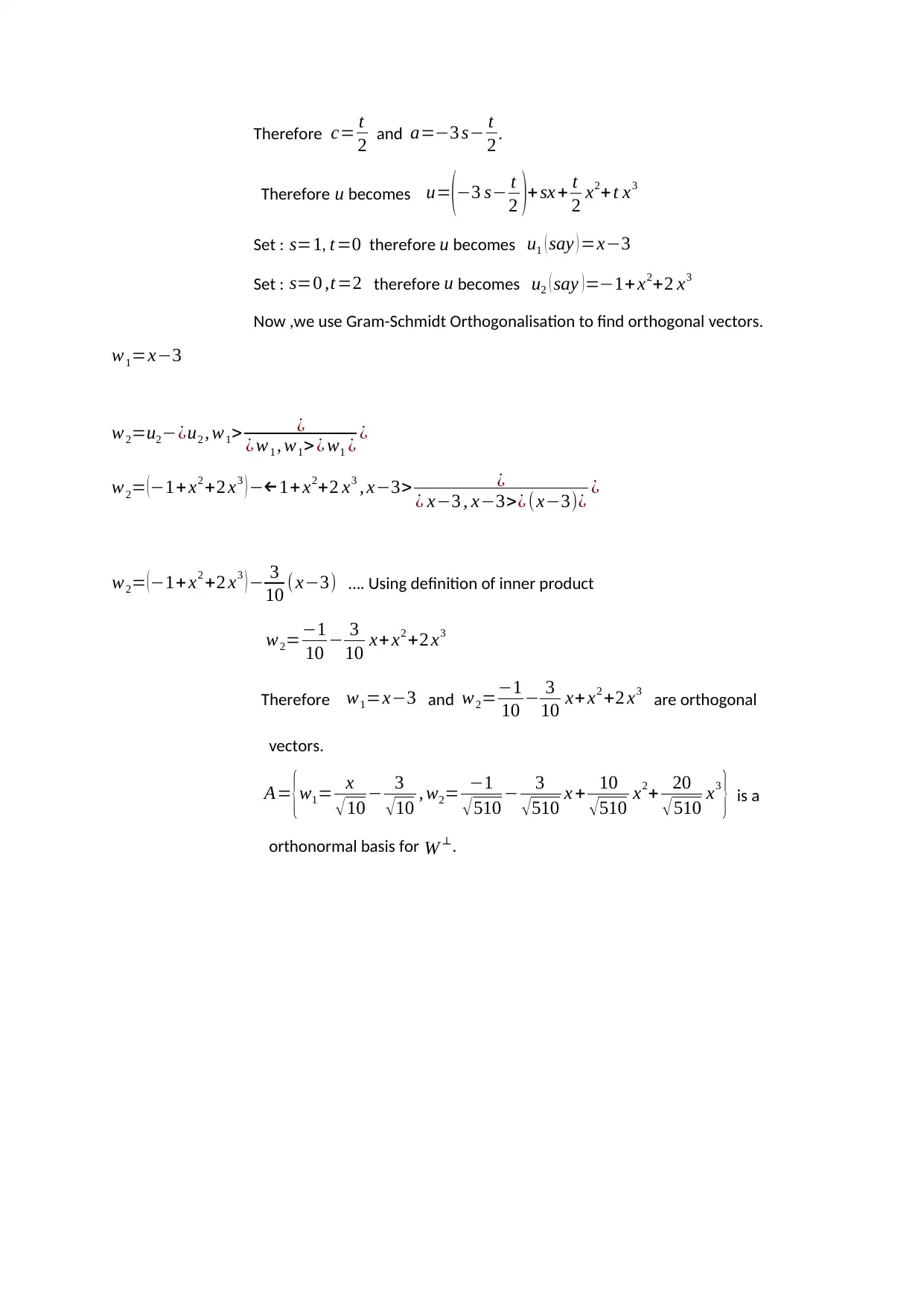
Therefore c= t
2 and a=−3 s− t
2 .
Therefore u becomes u=(−3 s− t
2 )+ sx + t
2 x2+ t x3
Set : s=1, t=0 therefore u becomes u1 ( say ) =x−3
Set : s=0 ,t=2 therefore u becomes u2 ( say )=−1+ x2+2 x3
Now ,we use Gram-Schmidt Orthogonalisation to find orthogonal vectors.
w1=x−3
w2=u2−¿u2 , w1> ¿
¿ w1 , w1> ¿ w1 ¿ ¿
w2= (−1+x2 +2 x3 ) −←1+x2+2 x3 , x−3> ¿
¿ x−3 , x−3>¿ (x−3)¿ ¿
w2= (−1+ x2 +2 x3 ) − 3
10 ( x−3) …. Using definition of inner product
w2=−1
10 − 3
10 x+ x2 +2 x3
Therefore w1=x−3 and w2=−1
10 − 3
10 x+ x2 +2 x3 are orthogonal
vectors.
A= {w1= x
√ 10 − 3
√ 10 , w2= −1
√ 510 − 3
√ 510 x + 10
√ 510 x2+ 20
√ 510 x3
} is a
orthonormal basis for W ⊥.
2 and a=−3 s− t
2 .
Therefore u becomes u=(−3 s− t
2 )+ sx + t
2 x2+ t x3
Set : s=1, t=0 therefore u becomes u1 ( say ) =x−3
Set : s=0 ,t=2 therefore u becomes u2 ( say )=−1+ x2+2 x3
Now ,we use Gram-Schmidt Orthogonalisation to find orthogonal vectors.
w1=x−3
w2=u2−¿u2 , w1> ¿
¿ w1 , w1> ¿ w1 ¿ ¿
w2= (−1+x2 +2 x3 ) −←1+x2+2 x3 , x−3> ¿
¿ x−3 , x−3>¿ (x−3)¿ ¿
w2= (−1+ x2 +2 x3 ) − 3
10 ( x−3) …. Using definition of inner product
w2=−1
10 − 3
10 x+ x2 +2 x3
Therefore w1=x−3 and w2=−1
10 − 3
10 x+ x2 +2 x3 are orthogonal
vectors.
A= {w1= x
√ 10 − 3
√ 10 , w2= −1
√ 510 − 3
√ 510 x + 10
√ 510 x2+ 20
√ 510 x3
} is a
orthonormal basis for W ⊥.
⊘ This is a preview!⊘
Do you want full access?
Subscribe today to unlock all pages.

Trusted by 1+ million students worldwide
1 out of 6
Related Documents
Your All-in-One AI-Powered Toolkit for Academic Success.
+13062052269
info@desklib.com
Available 24*7 on WhatsApp / Email
![[object Object]](/_next/static/media/star-bottom.7253800d.svg)
Unlock your academic potential
Copyright © 2020–2025 A2Z Services. All Rights Reserved. Developed and managed by ZUCOL.





